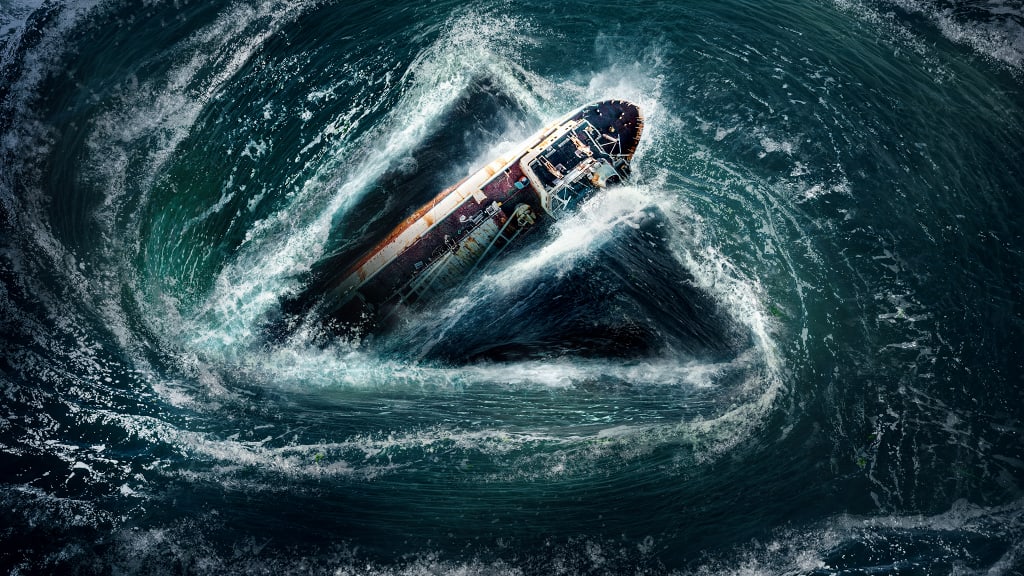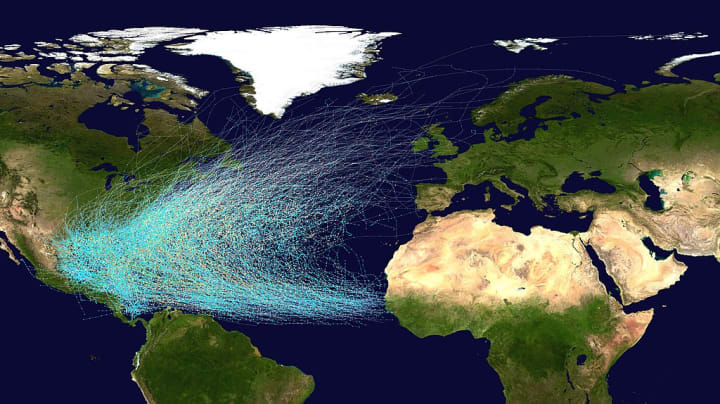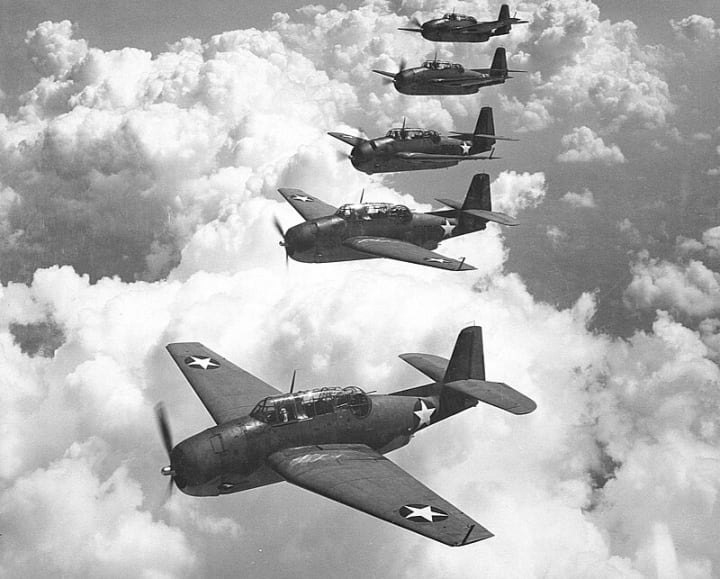
The Devil's Triangle, more commonly referred to as the Bermuda Triangle, is a myth surrounding a vaguely outlined area in the western North Atlantic Ocean where numerous planes and vessels have allegedly vanished under puzzling circumstances. The notion of this region being particularly susceptible to disappearances gained traction in the mid-1900s, yet the majority of credible references refute the existence of any enigma.
Origins
On September 17, 1950, an article written by Edward Van Winkle Jones of the Miami Herald was published in several American newspapers through the Associated Press. This article contained the earliest mention of peculiar disappearances in the Bermuda area.
Two years later, Fate magazine published an article titled "Sea Mystery at Our Back Door" by George X. Sand. This short article was the first to outline the well-known triangular area where the incidents occurred. Sand detailed the disappearances of various planes and ships since World War II. These included the vanishing of Sandra, a tramp steamer, in addition to the loss of Flight 19 in December 1945. Flight 19 consisted of five US Navy torpedo bombers on a training mission.
The article also mentioned the January 1948 disappearance of Star Tiger, a passenger airplane operated by British South American Airways (BSAA). Furthermore, it highlighted the March 1948 disappearance of a fishing skiff with three men, including jockey Albert Snider. Another incident mentioned was the December 1948 disappearance of an Airborne Transport DC-3 charter flight traveling from Puerto Rico to Miami. Lastly, the article referred to the January 1949 disappearance of Star Ariel, another BSAA passenger airplane.
Flight 19 was once again featured in the April 1962 edition of The American Legion Magazine. Author Allan W. Eckert mentioned that the flight leader was overheard saying, "We cannot be certain of any direction ... everything is amiss ... strange ... the ocean doesn't appear as it should." In February 1964, Vincent Gaddis published an article titled "The Deadly Bermuda Triangle" in Argosy, suggesting that Flight 19 and other disappearances were part of a series of peculiar occurrences in the area, dating back to at least 1840. The following year, Gaddis elaborated on this article in his book, Invisible Horizons.
Several authors expanded upon Gaddis' concepts, such as John Wallace Spencer (Limbo of the Lost, 1969, repr. 1973); Charles Berlitz (The Bermuda Triangle, 1974); and Richard Winer (The Devil's Triangle, 1974). Some of these writers integrated supernatural aspects into their works.
Triangle area
Sand's article in Fate provided a description of the region as a "watery triangle" that was roughly bounded by Florida, Bermuda, and Puerto Rico. The boundaries of this triangle were further clarified in the Argosy article by Gaddis, which identified Miami, San Juan (Puerto Rico), and Bermuda as its vertices.
However, subsequent writers did not always adhere to this definition. Different writers proposed alternative boundaries and vertices for the triangle, resulting in variations in the total area ranging from 1.3 to 3.9 million km2 (0.50 to 1.51 million sq mi). In fact, some writers even extended the triangle's reach as far as the Irish coast. As a result, the determination of which accidents occurred within the triangle relies on the specific writer who reported them.
Hypothetical explanation attempts
Persons accepting the Bermuda Triangle as a real phenomenon have offered a number of explanatory approaches.
Paranormal explanations
Triangle writers have utilized various supernatural concepts to elucidate the occurrences. One theory attributes the occurrences to advanced technology left behind by the legendary lost continent of Atlantis. Occasionally, this theory is linked to the submerged rock formation called the Bimini Road, located near the island of Bimini in the Bahamas, which falls within the boundaries of the Triangle according to certain definitions.
Devotees of the alleged psychic Edgar Cayce interpret his prediction that evidence of Atlantis would be discovered in 1968 as referring to the unearthing of the Bimini Road. Supporters describe the formation as a road, wall, or some other structure, but in reality, the Bimini Road is a natural formation.
There are those who speculate about the existence of a parallel universe within the Bermuda Triangle area, which creates a distortion in time and space, leading to the disappearance of objects into this parallel realm.[29] Alternatively, some attribute these occurrences to unidentified flying objects (UFOs).[30][31] Charles Berlitz, a renowned author who has extensively written about unusual phenomena, presents numerous theories that associate the disappearances in the Triangle with inexplicable or anomalous forces.[16].
Natural explanations

Violent weather
Hurricanes, formidable storms originating in tropical waters, have resulted in the loss of thousands of lives and billions of dollars in damages throughout history. The sinking of Francisco de Bobadilla's Spanish fleet in 1502 marked the earliest documented case of a devastating hurricane. These storms have been associated with various incidents related to the Bermuda Triangle. Numerous Atlantic hurricanes traverse the Triangle as they veer off the Eastern Seaboard, and prior to the introduction of weather satellites, ships frequently had minimal to no advance notice of an approaching hurricane.
Notable incidents
HMS Atalanta

The entire crew of the sail training ship HMS Atalanta (originally named HMS Juno) vanished after embarking on a journey from the Royal Naval Dockyard, Bermuda to Falmouth, England on 31 January 1880. It is believed that the ship sank during a severe storm that occurred a few weeks after its departure. The crew, consisting mainly of inexperienced trainees, may have contributed to the unfortunate outcome. The search for evidence regarding the ship's fate gained significant global attention at the time. Some also draw a connection to the loss of the training ship HMS Eurydice in 1878, which sank after leaving the Royal Naval Dockyard in Bermuda for Portsmouth on 6 March. However, claims that the ship fell victim to the mysterious triangle were later disproven by author David Francis Raine's research in 1997.
Flight 19

The entire crew of the sail training ship HMS Atalanta (originally named HMS Juno) vanished after embarking on a journey from the Royal Naval Dockyard, Bermuda to Falmouth, England on 31 January 1880. It is believed that the ship sank during a severe storm that occurred a few weeks after its departure. The crew, consisting mainly of inexperienced trainees, may have contributed to the unfortunate outcome.
The search for evidence regarding the ship's fate gained significant global attention at the time. Some also draw a connection to the loss of the training ship HMS Eurydice in 1878, which sank after leaving the Royal Naval Dockyard in Bermuda for Portsmouth on 6 March. However, claims that the ship fell victim to the mysterious triangle were later disproven by author David Francis Raine's research in 1997.
About the Creator
Enjoyed the story? Support the Creator.
Subscribe for free to receive all their stories in your feed. You could also pledge your support or give them a one-off tip, letting them know you appreciate their work.






Comments
There are no comments for this story
Be the first to respond and start the conversation.